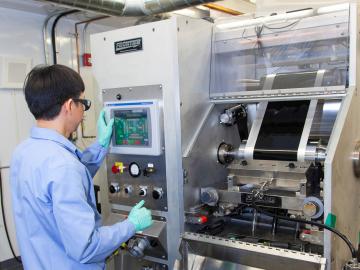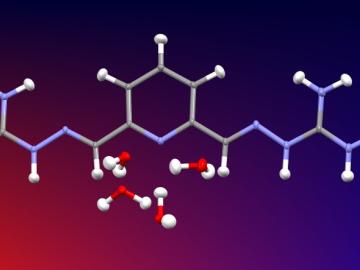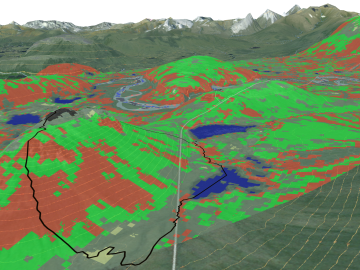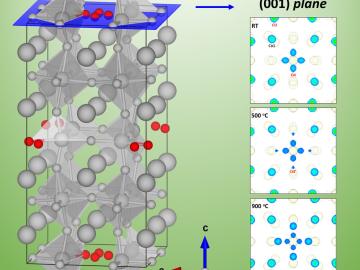
Filter News
Area of Research
- (-) Energy Science (173)
- (-) Fusion Energy (2)
- (-) National Security (34)
- (-) Neutron Science (42)
- Advanced Manufacturing (6)
- Biological Systems (1)
- Biology and Environment (130)
- Biology and Soft Matter (1)
- Building Technologies (2)
- Computational Biology (2)
- Computational Engineering (3)
- Computer Science (16)
- Electricity and Smart Grid (1)
- Energy Sciences (2)
- Functional Materials for Energy (2)
- Fusion and Fission (10)
- Isotopes (9)
- Materials (73)
- Materials for Computing (14)
- Mathematics (1)
- Nuclear Science and Technology (6)
- Quantum information Science (7)
- Supercomputing (147)
News Topics
- (-) Biomedical (21)
- (-) Computer Science (52)
- (-) Energy Storage (74)
- (-) Environment (64)
- (-) High-Performance Computing (12)
- (-) Machine Learning (21)
- (-) Mercury (3)
- (-) Summit (11)
- 3-D Printing/Advanced Manufacturing (86)
- Advanced Reactors (14)
- Artificial Intelligence (25)
- Big Data (13)
- Bioenergy (33)
- Biology (20)
- Biotechnology (6)
- Buildings (38)
- Chemical Sciences (17)
- Clean Water (10)
- Composites (18)
- Coronavirus (24)
- Critical Materials (9)
- Cybersecurity (25)
- Exascale Computing (2)
- Fossil Energy (3)
- Frontier (4)
- Fusion (18)
- Grid (43)
- Hydropower (3)
- Isotopes (1)
- Materials (48)
- Materials Science (51)
- Mathematics (3)
- Microelectronics (1)
- Microscopy (10)
- Molten Salt (1)
- Nanotechnology (18)
- National Security (37)
- Neutron Science (121)
- Nuclear Energy (23)
- Partnerships (16)
- Physics (11)
- Polymers (12)
- Quantum Computing (1)
- Quantum Science (9)
- Security (16)
- Simulation (4)
- Space Exploration (6)
- Statistics (1)
- Transportation (70)
Media Contacts

The use of lithium-ion batteries has surged in recent years, starting with electronics and expanding into many applications, including the growing electric and hybrid vehicle industry. But the technologies to optimize recycling of these batteries have not kept pace.

Researchers used neutron scattering at Oak Ridge National Laboratory’s Spallation Neutron Source to investigate the effectiveness of a novel crystallization method to capture carbon dioxide directly from the air.

Oak Ridge National Laboratory scientists have created open source software that scales up analysis of motor designs to run on the fastest computers available, including those accessible to outside users at the Oak Ridge Leadership Computing Facility.

A team of scientists led by Oak Ridge National Laboratory used machine learning methods to generate a high-resolution map of vegetation growing in the remote reaches of the Alaskan tundra.

A University of South Carolina research team is investigating the oxygen reduction performance of energy conversion materials called perovskites by using neutron diffraction at Oak Ridge National Laboratory’s Spallation Neutron Source.
![Coexpression_hi-res_image[1].jpg Coexpression_hi-res_image[1].jpg](/sites/default/files/styles/list_page_thumbnail/public/Coexpression_hi-res_image%5B1%5D_0.jpg?itok=ww635BCP)
While studying the genes in poplar trees that control callus formation, scientists at Oak Ridge National Laboratory have uncovered genetic networks at the root of tumor formation in several human cancers.

Oak Ridge National Laboratory scientists studying fuel cells as a potential alternative to internal combustion engines used sophisticated electron microscopy to investigate the benefits of replacing high-cost platinum with a lower cost, carbon-nitrogen-manganese-based catalyst.

To learn more about interactions between drug molecules and micelles, Associate Professor Megan Robertson and graduate students Tyler Cooksey and Tzu-Han Li from the University of Houston (UH) are using neutrons at the Department of Energy’s (DOE’s) Oak Ridge National Laboratory (ORNL).
![2018-P07635 BL-6 user - Univ of Guelph-6004R_sm[2].jpg 2018-P07635 BL-6 user - Univ of Guelph-6004R_sm[2].jpg](/sites/default/files/styles/list_page_thumbnail/public/2018-P07635%20BL-6%20user%20-%20Univ%20of%20Guelph-6004R_sm%5B2%5D.jpg?itok=hUSyvkP0)
A team of scientists, led by University of Guelph professor John Dutcher, are using neutrons at ORNL’s Spallation Neutron Source to unlock the secrets of natural nanoparticles that could be used to improve medicines.
Scientists studying a valuable, but vulnerable, species of poplar have identified the genetic mechanism responsible for the species’ inability to resist a pervasive and deadly disease. Their finding, published in the Proceedings of the National Academy of Sciences, could lead to more successful hybrid poplar varieties for increased biofuels and forestry production and protect native trees against infection.


